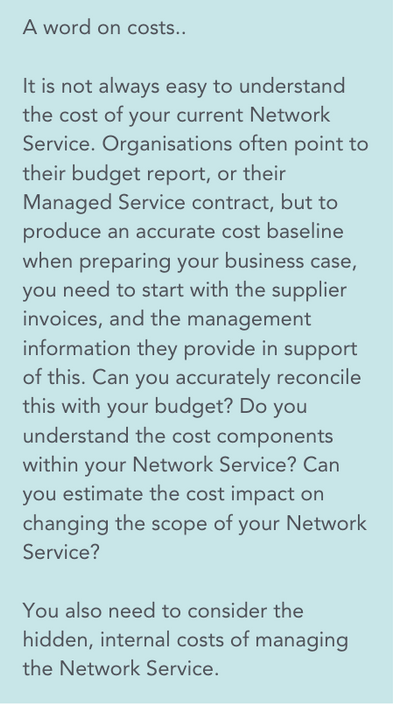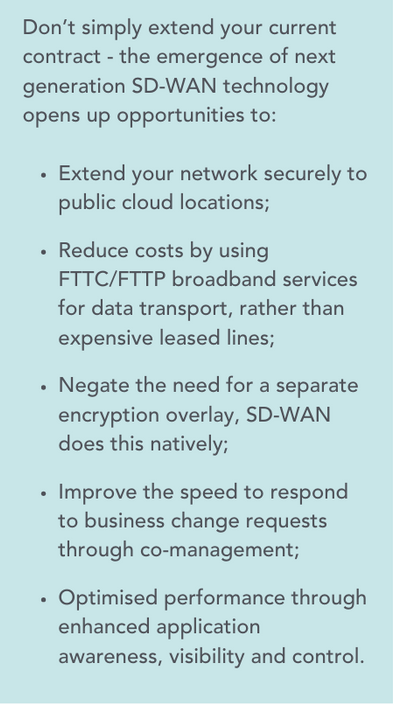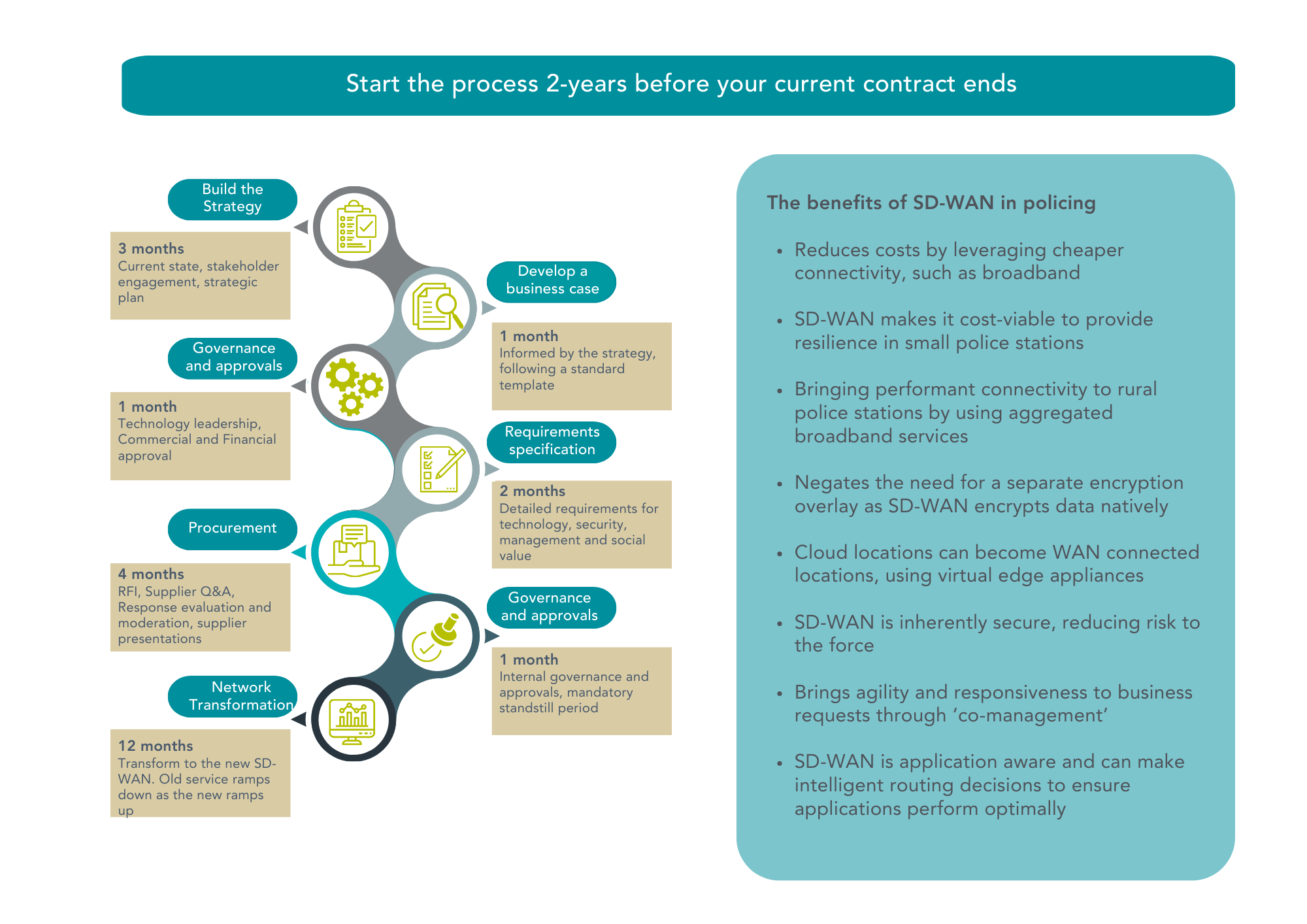Don’t leave it too late to start the procurement of your next generation WAN service
Share:
Date:
January 2024

key fact
Next-generation SD-WAN technology is delivering significant advantages within Policing. Opportunities for transformation don’t come often and it may take longer and be more involved than you think – we explore how to prepare for success.
Software Defined Wide Area Network, or SD-WAN, is now an established and proven technology and offers a range of benefits to UK Police Forces. These benefits include:
- Faster, more reliable communication
- Robust security applied consistently across the estate
- Improved access to cloud services (such as Axon Evidence)
- An improved front-line Police Officer technology experience.
The opportunity to refresh your WAN only comes round every 5 – 7 years, so it’s important to be ready for it. The following guide aims to help you take the most efficient path to transformation of your legacy Network.
Create a Network Strategy
 The fundamental starting point is to create a Network Strategy, encapsulating in a single concise document the ’as-is’ situation in terms of the technology, cost, commercial and operational aspects as well as detailing the future requirements to be placed on the network. Effective engagement with key stakeholders across the organisation is critical to understanding the plans and aspirations for those areas that will need to be underpinned by the Network, including:
The fundamental starting point is to create a Network Strategy, encapsulating in a single concise document the ’as-is’ situation in terms of the technology, cost, commercial and operational aspects as well as detailing the future requirements to be placed on the network. Effective engagement with key stakeholders across the organisation is critical to understanding the plans and aspirations for those areas that will need to be underpinned by the Network, including:
- Digital Policing
- Key operational applications
- Hosting and cloud strategy
- End-user computing strategy
- Telephony and UC strategy
- Estates strategy
- Partnership and collaboration initiatives
- Devices
- End user quantities
- User persona’s
- Network video requirements (Body worn video, CCTV, and conferencing) Digital Forensics
- Custody Suites
- Control room strategy
- BCDR and security requirements.
Having gained a snapshot of the current estate and a clear vision of the functional and organisational requirements: The next stage is to create a costed 5 to 7-year plan that addresses the capability gaps and transforms the legacy WAN into a right-sized, flexible, performant and efficient network that will deliver the strategic network requirements for the organisation.
 Build a Business Case
Build a Business Case
Transformation inevitably requires investment. Informed by the Network Strategy, build a business case aimed at securing the funding and gaining senior-level sponsorship for the project.
Recent experience shows that the change from traditional fully managed MPLS networks with an encryption overlay to new SD-WAN technology can significantly reduce Network run costs, and ‘doing more for less’ improves the chances of success for your Business Case.
In addition, the central orchestration platform of SD-WAN lends itself to a ‘co-managed’ approach, where the supplier provides proactive monitoring, incident response, break fix and general housekeeping, enabling internal team to make changes to the Network, speeding up responsiveness to requests for change, and improving operational agility.
Plan and execute your procurement
As you will be working with your incumbent supplier for a while longer, we recommend that you maintain a healthy relationship, engage with them to share your plans. Request that they provide you with an Exit Plan and check they are prepared to offer technical assistance, if required, during your move to the new Network (especially important if they are not the successful supplier). Consider if they will be invited to participate in the competitive tender and let them know. Also consider if the old service can be ramped down, without financial penalty, as the new service ramps up, to minimise dual-run costs.
Again, drawing from the Network Strategy, develop a detailed requirements specification and prepare to go to market. We would recommend the Crown Commercial Services Network Services 3 framework as this gives access to a broad marketplace with considerable experience running SD-WAN Networks within policing. Try not to be too prescriptive with your requirements – allow the suppliers to innovate and to put their best solution forward.
Transform your technology and service
 The supplier will lead the project and provide appropriate resources to design and deploy your new SD-WAN, but this will inevitably require input and involvement from your network team, approving designs, supervising engineer visits, scheduling changes, testing during cutover and closing down the old service. Ensure the supplier clearly state their dependencies and you have the capacity to support the project, utilising external resources to backfill and support if necessary.
The supplier will lead the project and provide appropriate resources to design and deploy your new SD-WAN, but this will inevitably require input and involvement from your network team, approving designs, supervising engineer visits, scheduling changes, testing during cutover and closing down the old service. Ensure the supplier clearly state their dependencies and you have the capacity to support the project, utilising external resources to backfill and support if necessary.
SD-WAN is application aware and can select the most efficient traffic path to ensure optimal performance of the applications, as perceived by the end user. Knowledge of your key application architecture will be important during the design phase.
If you opted for a ‘co-managed’ service, your new contract should include the provision of formal training for your technical team, ensuring that they are able to administer the new SD-WAN. Your team will also benefit from collaborating with the supplier’s technical resources during the design and build stages.
Experience tells us that organisations who are most satisfied with their Network providers are the ones who actively manage them – ensure that you adopt a robust governance model and manage your supplier’s performance closely for the duration of the contract. Give priority to the periodic review meetings and ensure that all obligations and performance metrics are appropriately measured and managed. Treat your supplier as a partner, sharing your plans and projects and listening to their suggestions for innovation.
Leave enough time
The optimum time to start planning your Network transformation is 2-years before the end of your current contract. Organisations often underestimate the time required to properly prepare for the procurement, to gain the necessary approvals, and sometimes skip the initial, critical step of developing a definitive strategy, which has implications for the later steps in the process.
To avoid having to extend the legacy service, something which may not be commercially palatable, you should aim to transition to your new contract during the last year of the current contract term, which means your strategy, business case and procurement must be successfully completed prior to this. The high-level timeline graphic estimates the time required for each stage in this process.
Plan an efficient and effective transformation by establishing when your current service expires and starting the replacement process two years in advance. By giving yourself enough time, you can develop a clear view of your organisational requirements and priorities, and a detailed understanding of your current costs and capabilities. You can then use this to engage collaboratively with the market and leverage supplier experience to successfully transform to the new service, to secure the advantages of the next generation network technology as quickly as possible.
We hope you find this insight informative and helpful. If you’d like discuss this insight or have any questions, email contact@masonadvisory.com to discuss further.
If you want to find out more about our services, click here.
